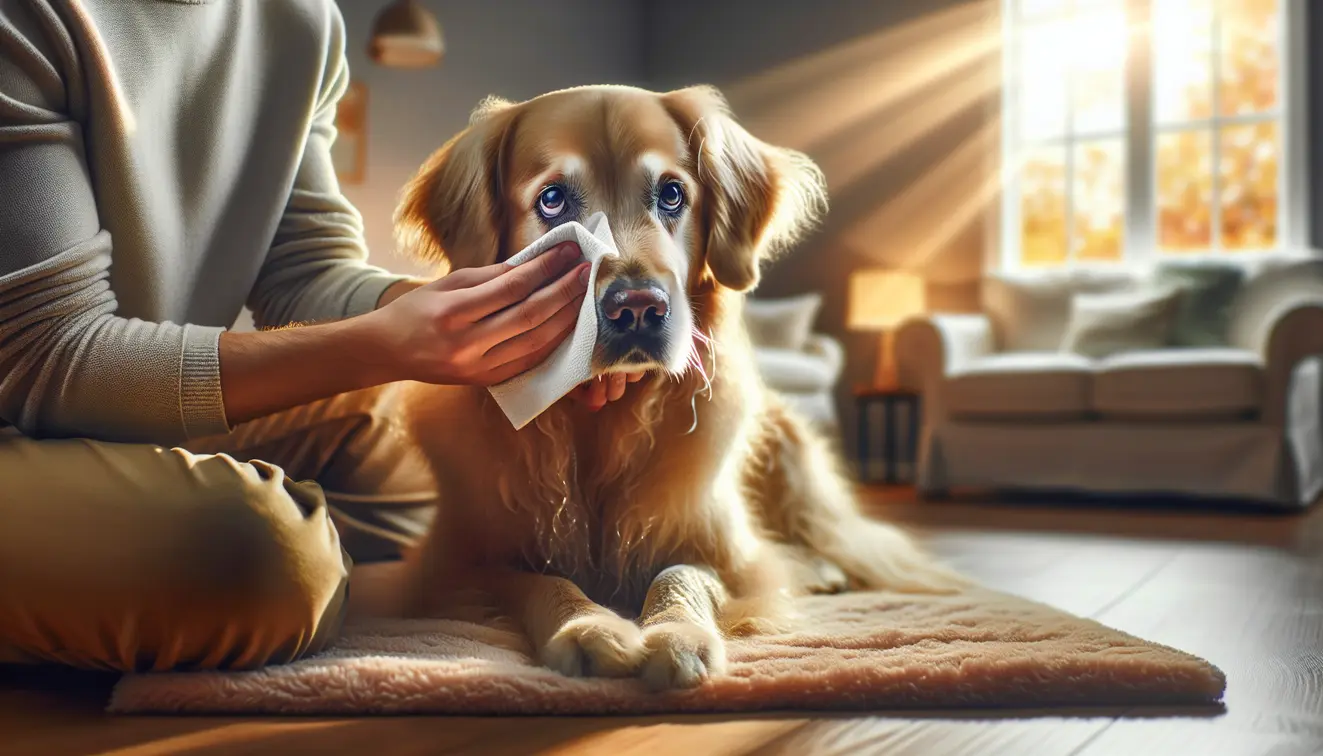Home Remedies for Pink Eye in Dogs: Soothe Your Pup’s Eyes Naturally
Estimated reading time: 7 minutes
Key Takeaways
- Pink eye, or conjunctivitis, in dogs is often caused by infections, allergies, or irritants.
- Home remedies like saline rinses and chamomile compresses can offer gentle relief for mild cases.
- Always consult a vet before starting treatments to ensure safety and address underlying issues.
- Monitor symptoms closely and seek veterinary care if conditions persist or worsen after 48–72 hours.
- Prevention through hygiene and regular checkups can reduce the risk of recurrence.
Table of Contents
- Introduction to Home Remedies for Pink Eye in Dogs
- What is Pink Eye in Dogs? Symptoms and Causes
- Safety First: Precautions Before Using Home Remedies
- Safe and Effective Home Remedies for Pink Eye in Dogs
- Supporting Your Dog’s Recovery at Home
- When to Seek Veterinary Care
- Preventing Pink Eye in Dogs
- Frequently Asked Questions (FAQs) About Pink Eye in Dogs
Introduction to Home Remedies for Pink Eye in Dogs
Caring for a dog with pink eye can tug at any pet owner’s heart. At WikiHomeRemedies, we understand your concern and want to guide you through safe, natural ways to ease your pup’s discomfort. Pink eye, or conjunctivitis, involves inflammation of the conjunctiva, the thin tissue covering the eye, often triggered by allergies, infections, or irritants.
This article offers practical, vet-backed home remedies to support your dog’s recovery. We know how much you value your furry friend’s well-being, so we’ve rooted our advice in trustworthy insights from sources like the ASPCA and PetMD. Eye issues affect many dogs—statistics from the American Kennel Club suggest a notable prevalence of such conditions—and being prepared matters.
Before we dive in, a gentle reminder: these remedies complement, not replace, veterinary care. If your dog’s symptoms persist or worsen, a vet visit is essential. Let’s explore how to help your pup naturally and safely.
What is Pink Eye in Dogs? Symptoms and Causes
Pink eye in dogs, known as conjunctivitis, is an inflammation of the conjunctiva, the delicate membrane surrounding the eye. This condition can make your dog uncomfortable, often showing through redness or irritation. It’s a common issue, but understanding its roots helps in providing the right care.
Symptoms can vary, but they often include visible signs that something’s off with your pup’s eyes. Causes range widely, from infections to environmental factors, and pinpointing the trigger is key to effective support. Home remedies can play a role, but they work best alongside a clear grasp of what’s happening.
Think of a dog who’s been playing outside on a dusty day. That dust might irritate their eyes, leading to mild pink eye. According to PetMD, such cases are frequent, and knowing the signs and sources equips you to act wisely. For more on managing eye discharge in dogs, check out this resourceful guide.
Recognizing Symptoms of Pink Eye
Seeing your dog struggle with eye discomfort is tough. Here are the telltale signs to watch for:
- Redness in the white part of the eye, often quite noticeable.
- Excessive tearing, making the eye appear wetter than usual.
- Colored discharge, like yellow or green, hinting at infection.
- Squinting or blinking more often due to pain or sensitivity.
- Pawing at the eye, a sign they’re trying to relieve irritation.
Noticing these early can make a difference. Keep a close watch to share details with your vet if needed.
Common Causes of Pink Eye in Dogs
Understanding why your dog has pink eye helps tailor the best response. Below are the primary culprits:
- Infections: Bacterial or viral agents can inflame the eye, often spreading from other dogs.
- Allergies: Pollen, dust, or mold may trigger reactions, especially in sensitive pups.
- Irritants: Smoke, chemicals, or even shampoo can bother the conjunctiva.
- Physical Trauma: A scratch or foreign object, like a grass seed, can spark inflammation.
The American Kennel Club notes allergies are a leading cause in certain breeds. Identifying the source ensures you pick supportive care that truly helps. If allergies are a concern for your pup, you might find additional helpful tips here: home remedies for dog allergies.
Safety First: Precautions Before Using Home Remedies
Before trying any home remedy for your dog’s pink eye, pause and prioritize safety. Your pup’s eyes are delicate, and well-meaning efforts can sometimes do more harm than good. Consulting a veterinarian first isn’t just a suggestion—it’s a vital step to avoid missteps that could worsen the condition.
Vets bring clarity to the cause, whether it’s a simple irritant or a deeper infection. Without their input, you might miss underlying issues, risking complications. The ASPCA warns that delaying professional care can lead to lasting damage, so let’s tread carefully.
Monitoring symptoms closely is also key. Note changes in discharge or behavior daily, as this log can guide your vet. Avoid rushing into treatments without guidance—safety always comes before speed.
Why Consult a Vet First?
A vet’s expertise is your best starting point. Self-diagnosis might seem quicker, but it carries risks like missing a severe infection. Untreated, some conditions can threaten your dog’s vision, so professional insight ensures you’re on the right path.
Vets can test for deeper problems, like glaucoma, hidden behind pink eye symptoms. Their advice aligns treatment with the true cause. Trust their knowledge before proceeding with any home care.
What to Avoid When Treating Pink Eye at Home
Steer clear of common pitfalls when helping your dog. Here are practices to avoid:
- Using human eye drops unless explicitly prescribed by a vet.
- Applying harsh chemicals or soaps near the eye area.
- Handling tools or cloths that aren’t sterilized, risking further irritation.
Veterinary warnings highlight cases where improper care caused setbacks. Stick to safe, vet-approved methods as we move into remedies. Your caution keeps your pup protected.
Safe and Effective Home Remedies for Pink Eye in Dogs
If your vet gives the green light, natural remedies can offer gentle relief for mild pink eye in dogs. We’ve gathered five safe approaches, backed by insights from sources like PetMD, to help soothe your pup’s eyes. These methods focus on comfort and cleanliness, supporting recovery without harsh interventions.
Always monitor how your dog responds. If symptoms don’t ease within a couple of days or seem to worsen, stop the remedy and reach out to your vet. Let’s walk through each option with clear steps, ensuring you can apply them confidently and keep safety at the forefront.
-
- Saline Solution Rinse
A simple saline rinse can clear debris or discharge from your dog’s eye. To prepare, mix 1/4 teaspoon of non-iodized salt into 1 cup of distilled, boiled, and cooled water. Use a sterile dropper or cotton ball to gently flush the eye, wiping away from the corner. Repeat 2–3 times a day, and always use fresh solution. Vets often approve saline for its mild cleansing effect. Discard any leftover mix to avoid contamination.
- Saline Solution Rinse
-
- Chamomile Tea Compress
Chamomile’s calming properties can reduce inflammation around the eye. Brew a caffeine-free chamomile tea bag in hot water, then let it cool completely. Soak a clean cloth in the tea, wring it out, and place it over your dog’s closed eye for 5 minutes, 1–2 times daily. Ensure it’s not hot before applying. Herbal vet resources note chamomile’s safety for mild irritation. If your dog resists, don’t force it.
- Chamomile Tea Compress
-
- Warm Compress
A warm compress eases swelling and offers comfort. Dampen a clean cloth with lukewarm water, test it on your wrist to confirm it’s not hot, then hold it gently over the closed eye for 3–5 minutes. Do this 2–3 times a day as needed. It’s a straightforward, vet-recommended way to soothe irritation. Always recheck the temperature to prevent burns.
- Warm Compress
-
- Calendula Solution
Calendula has natural antibacterial traits, helpful for minor eye issues. Buy a vet-approved, diluted calendula tincture and follow package instructions, usually a few drops in water. Apply it around the eye with a clean cloth, never directly inside, once or twice daily. Vet studies on calendula are limited but suggest promise for external use. Double-check with your vet before starting.
- Calendula Solution
- Hygiene Maintenance
Keeping the eye area clean prevents worsening. Use a soft, damp cloth to wipe away discharge, always moving outward. Trim fur around the eyes if it traps dirt, and use separate cloths for each eye to avoid cross-contamination. Wash bedding often to reduce irritants. Vets agree hygiene is fundamental. Make this a daily habit during recovery.
Supporting Your Dog’s Recovery at Home
Beyond remedies, creating a healing space for your dog boosts their recovery. Small changes to their environment or routine can lessen eye strain and irritation. Your care in these details shows, helping your pup feel better faster.
Consider reducing allergens around them. Vacuum often to cut down on dust, and keep windows closed during high-pollen days. Wash their bedding weekly to clear potential triggers.
Diet can also play a role. With vet approval, foods rich in omega-3 fatty acids, like certain fish oils, may support eye health, as noted by PetMD. Keep stress low by sticking to familiar routines.
Prevent scratching with a cone if they paw at their eyes. A calm, comfy spot to rest, away from harsh light, aids healing too. Your thoughtful adjustments make recovery smoother. For additional support on skin-related irritations caused by scratching, explore this guide: home remedies for dogs itching skin.
When to Seek Veterinary Care
Home remedies have their place, but they’re not always enough. If your dog’s pink eye lingers beyond 48–72 hours or gets worse, it’s time for a vet’s help. Knowing when to step in can safeguard your pup’s vision and health.
Watch for warning signs that signal urgency. These include:
- Persistent redness or swelling despite consistent care.
- Thick, yellow, or green discharge that doesn’t lessen.
- Changes in behavior, like lethargy or refusing food.
- Squinting that intensifies or sudden sensitivity to light.
Untreated issues might lead to complications, even vision loss, as the ASPCA highlights. A vet can run diagnostics to uncover hidden causes, like infections or glaucoma. They may prescribe targeted treatments, from antibiotics to specialized drops.
Don’t hesitate if something feels off. A quick vet visit can prevent bigger problems, ensuring your dog’s eyes stay healthy. Trust your instincts—they’re often spot-on.
Preventing Pink Eye in Dogs
Keeping pink eye at bay starts with proactive care. Prevention reduces the chance of recurrence, sparing your dog discomfort and you worry. Simple, consistent habits can protect their eyes for the long haul.
Start with regular eye checks. Glance at their eyes weekly for redness or discharge, catching issues early. Clean their bedding and toys often to minimize dust and germs, as the American Kennel Club advises.
Limit exposure to irritants. Avoid walking in smoky areas or near harsh chemicals, and rinse their face after outdoor play to clear pollen. A clean environment cuts down risks.
Vaccinations and vet checkups also help. Some infections tied to pink eye can be prevented with updated shots. Building these steps into your routine creates a shield for your pup’s precious eyes. For more on managing potential infections like ear issues that could spread to the eyes, see: home remedies for ear infection in dogs.
Frequently Asked Questions (FAQs) About Pink Eye in Dogs
Pet owners often have pressing questions about pink eye. We’ve answered a few common ones to ease your mind with clear, reliable information.
Can I use human eye drops for my dog?
No, unless your vet specifically prescribes them. Human formulations can harm dogs, causing irritation or worse. Always seek veterinary guidance first, as the ASPCA advises.
How long does pink eye last in dogs?
With proper care, it often resolves in 1–2 weeks. If there’s no improvement after 3 days, consult a vet. Delaying can risk complications.
Are home remedies safe for puppies?
Puppies are more vulnerable, so extra caution is needed. Home remedies might not suit their delicate systems. Always check with a vet before trying anything.
Can pink eye spread to humans or other pets?
It’s rare, but it depends on the cause. Bacterial or viral forms might transfer through contact, so wash hands after handling. Maintain hygiene to limit any risk.










